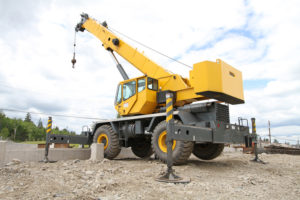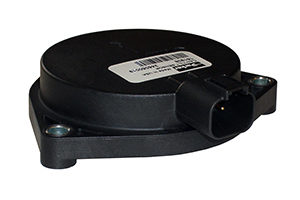
Rear quarter view of a jacked up mobile crane on a construction site.
Mobile equipment manufacturers are always striving to get the most out of their machines without overburdening the system with costly and complex mechanics. Moreover, performance expectations are not only shaping machine needs but also safety requirements. Consequently, this has driven many engineers to design closed-loop systems featuring electronic sensors as feedback devices.
For example, manufacturers of lifting equipment such as truck mounted cranes, telehandlers and scissor are all striving to provide operators with safe work environments all the while maintaining the integrity of the lifting function during operation. The choices for detecting or measuring tilting/leveling conditions are vast. They range from purely mechanical devices: tilt gauges and bubble levels for simple visual indication to basic electronic sensors offering discrete tilt switch points. While these options are typically cost-effective, they offer little to no feedback for safety or performance.

The UTS, manufactured by Parker’s Electronic Controls Division, is a MEMS technology tilt sensor designed for configurability making. It is suitable for a broad range of mobile applications. The UTS communicates via SAE J1939 protocol providing fast and reliable angular information from either two or three axes.
The Universal Tilt Sensor
Design engineers are increasingly relying on sophisticated sensor technology for fast accurate feedback and diagnostics during operation. Today’s systems require something more; electronic inclinometers that offer continuous monitoring of angular position in relation to a calibrated reference planes either horizontal or vertical. The latter can best be accomplished with Parker’s Universal Tilt Sensor (UTS).
The UTS, manufactured by Parker’s Electronic Controls Division, is a MEMS technology tilt sensor designed for configurability making. It is suitable for a broad range of mobile applications. The UTS communicates via SAE J1939 protocol providing fast and reliable angular information from either two or three axes. The patented 3-point setup and low-profile housing offer ease of installation, reduced build time, and maximize install possibilities. Since some applications require a balance of speed and accuracy, the UTS also offers tunable filter settings to adjust the output response on command. Three factory variations are available by catalog today:
- X,Y axis +/- 10 deg
- X,Y axis +/- 90 deg
- X,Y, Z axis +/- 90 deg
Auto-leveling
Most vehicles with lifting booms require the chassis platform to be level with the ground before the boom and load can be elevated above a certain point and/or rotated around its base axis. This helps ensure the safety of the operator and payload. A chassis mounted UTS can continuously monitor changes in inclination during the deployment of the stabilizing actuators (outriggers and jacks) to feed the control system real-time information throughout the leveling process. This feedback can ensure a uniform lift even on the most challenging terrain.
While a system using the UTS for auto level can be made simple as a one-touch function, it can also offer continuous monitoring of the chassis as different loads and mechanical movement adjust the center of mass of the platform. The continuous feed of information can provide real-time feedback on out-of-level conditions alerting the control system and operator of potentially danger inclination. Finally, the sensor provided an operator display a real-time visualize of tip and tilt for manual adjustments where needed.
In cases where the chassis has an overextended wheelbase, i.e. ladder engine or multi-axle crane trucks, two UTS sensors could be used; one in the fore and one in the aft part of the chassis. By monitoring the pitch and roll condition of the chassis in two locations simultaneously, a machine can utilize the UTS output to prevent excessive twisting along its longitudinal axis of the platform frame thus preventing costly repairs to the machine.
This is just one of many ways the UTS can be used in a closed-loop system to achieve optimum performance and peak safety on mobile platforms. It has been built to operate in the most demanding marketplaces including agriculture, construction, material handling and more.
Parker Hannifin
parker.com
Filed Under: Mobile Hydraulic Tips